
Too Much Happiness
By Alice Munro
Knopf, 320 pp., $25.95
Alice Munro, acclaimed
Canadian writer and recipient of the 2009 Man Booker International
Prize, has delivered something dark and exquisite with her new
collection of short stories, Too Much Happiness. In it, Munro
continues to explore the complexities of relationships and
self-awareness, all with a precision and shrewdness about the worlds
she creates. Each story reads smoothly, even as it sometimes tears at
something violent and disturbing.
From the opening story, the collection has an air of tragedy: A
woman loses her three children in unusual circumstances and is faced
with an unthinkable emotional dilemma. Then: A recently widowed woman
takes on a surprising role to save herself from an intruder. A dying
man is the object of conflicting desires. An estranged son betrays the
shortcomings of a marriage. A woman recalls a shocking and sinister act
she committed as a child.
Munro has spent a lifetime writing short stories, which explains her
mastery of the genre where her forceful simplicity reigns supreme. But
she seems to be aware of how the genre is sometimes perceived —
as a stepping stone to the longer form (and greater art?) of the novel.
In one humorously self-referential moment, one of her characters
says:
“[It] is a collection of short stories, not a novel. This in and of
itself is a disappointment. It seems to diminish the book’s authority,
making the author seem like somebody who is hanging on the gates of
Literature rather than safely settled inside.”
Perhaps here Munro is only proving her vast ability to write from
multiple, even opposing viewpoints. Her stories cover eras and
countries. They take on genders and generations. They give voice to a
betrayer and the betrayed. For these reasons, and for many others,
Alice Munro has secured herself a place inside those gates. —
Hannah Sayle

The Humbling
By Philip Roth
Houghton Mifflin, 160 pp., $22
The protagonist of The Humbling, Philip Roth’s latest book,
is Simon Axler, an aging stage actor who has lost the trick of being
someone else. It’s not exactly stage fright that has him frozen and
fearful; it’s an inability to believe in the process of acting,
illusion. He cannot escape Simon Axler.
Left to himself (after a stay in a sanitarium and after his wife has
left him), Axler moves to a secluded house to end his days in
isolation. But he can’t escape his self-absorption and it turns into
poison, so much so that he is contemplating the ultimate exit: suicide.
Into this solitude comes the daughter of old friends, a lesbian college
teacher named Pegeen. An unlikely affair blossoms between them,
temporarily staving off Axler’s darker imaginings.
Roth’s writing here has a wildness to it, as if he’s writing in a
fever. Perhaps Roth himself feels that way. The Humbling is a
meditation on mortality, and as with all of Roth’s writing, he is
fearless, even in the face of the final question. Roth tears at his
themes with unblinking honesty and stripped-down prose. Perhaps Roth,
now 76, is writing according to his own sensibility. Gone are the
bed-hopping miscreants of his earlier novels, replaced here by an
introspective older protagonist, who is staring into the abyss.
Not to say that Roth eschews the sexual element. Axler does okay for
a man who considers himself dried up. Roth has always plumbed the
carnal side of his characters, and, like Updike, he does so with
unflinching frankness. But Roth also treats his protagonist here with
empathy and authenticity.
Readers of Roth understand that he takes risks other writers
circumvent. It is this daring that defines Roth and places him in the
front ranks of the novelists of our time. — Corey
Mesler

It’s a Gift
Like the story it’s based on, Joel Priddy’s new
graphic adaptation of The Gift of the Magi
(It Books/HarperCollins, $14.99) is deceptively
simple. You may well remember the O. Henry
tale from grade school: Christmastime, a married
couple struggles with what to gift each other on
such mean savings and wind up exchanging presents that are
ironically and heartbreakingly inappropriate. But it’s the loving
thought that counts. Cut, print, preserve.
Not so fast. Priddy — who teaches illustration and cartooning
at the Memphis College of Art — revivifies the chestnut and finds
in it volumes of wordless charm. The cartoonist emphasizes the emotions
of each moment, in each panel, suffusing them with such meaning that
the gotcha ending becomes less a startling plot point and more a
symbolic embodiment of the couple’s love.
Priddy packs a punch. The visual centerpiece is luxurious golden
hair flowing across several pages — a lively illustrative
presence like one of Beto Hernandez’s skies.
The Gift of the Magi can be bought separately or as a
stocking-sized holiday gift set with an illustrated version of Hans
Christian Andersen’s The Fir-Tree (adapted by Lilli
Carré) and L. Frank Baum’s A Kidnapped Santa Claus
(adapted by Alex Robinson), also from It Books. — Greg
Akers
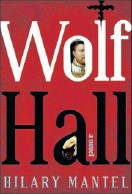
Wolf Hall
By Hilary Mantel
Henry Holt, 560 pp., $27
Hilary Mantel was amazed when she won the 2009 Man Booker Prize. Her
Wolf Hall was a critics’ favorite. “They say the favorite never
wins,” she explained to me by e-mail, but Wolf Hall was favored
for a reason: A good man is hard to find.
That man is Thomas Cromwell, born in Tudor London, a commoner whose
rush to power makes a king, Henry VIII, declare him Earl of Essex. As
Henry’s chief adviser, Cromwell boasts a usefulness that never keeps
his hands quite clean enough for courtiers.
This novel, Mantel’s 10th, is peopled with historical figures: Ann
Boleyn, Thomas Cranmer, Thomas More. It shows us Cromwell’s rise to
stand among them. Historically, Cromwell led a public life where
secrets die crying, but fiction fills the gaps. Mantel writes of “the
intimacies of politics” that muscle a blacksmith’s son to a king’s
can-man. You want the world? Cromwell delivers and asks, “What
color?”
A buoyant wit lures us into Cromwell’s domain. Thanks to Mantel, we
come to know a living being. As the author said last year of Wolf
Hall, “There’s a man in there!”
Watch him skirt the fall of his first master, Cardinal Wolsey, with
an ease that aims him where Wolf Hall ends. Mantel leaves her
man some five years shy of his end: an ax on July 28, 1540. “So now I
have the next one to write, you see,” Mantel says.
Cromwell’s climb from soot to king’s supper is Wolf Hall. His
tumble from the Tower is in the offing. Know the outcome? No matter.
Mantel specializes in resurrection.
I met Hilary Mantel on the subject of Robespierre on a 28th of July,
the date Robespierre’s head fell in 1794. But that’s the stuff of
synchronicity, other stories. For the present, crack Wolf Hall.
Cromwell’s in there. He wants out.
— Alice Long
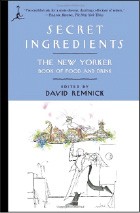
Hungry?
By 1974, Ruth Lockwood had logged a dozen years producing The
French Chef for WGBH in Boston, working alongside Julia Child, the
show’s unflappable host. Despite a hectic schedule — sometimes
taping four shows a week — Lockwood said Child never lost her
temper. Except once. A dish towel and pot holder caught fire on the
set, and the cameramen stopped shooting. Child was furious. She wanted
the mishap filmed to show viewers what to do if the same thing happened
at home.
Lockwood’s story is one anecdote among many in an article by Calvin
Tomkins first published 35 years ago and reprinted in a remarkable
collection of food writing from The New Yorker called Secret
Ingredients (Modern Library, $18). Edited by David Remnick, the
magazine’s editor today, the tell-alls, essays, memoirs, cartoons, and
short stories are a welcome reminder that Americans were passionate
about food and drink long before reality television.
At The New Yorker, distinguished food writers have helped
steer the magazine’s content throughout its history, beginning in 1935
with A.J. Liebling, who in his essay “A Good Appetite” wrote, “Each day
brings only two opportunities for field work, and they are not to be
wasted minimizing the intake of cholesterol.”
In all, more than 50 contributions make up this celebration of
writing and food. Some stories are poetic, like M.F.K. Fisher’s lament
(in “Secret Ingredient”) for the “witches of yesterday” who zealously
guard their favorite recipes. Other pieces are rich with conversation
and memory, like John McPhee’s portrait of forager Euell Gibbons, one
of the fathers of the natural foods movement.
“What the editors who created The New Yorker understood is
that a magazine travels not only with its mind but also, like an army,
on its stomach,” Remnick writes in his introduction to Secret
Ingredients, an evaluation applicable, as well, to the lucky
readers who discover this book, first published a couple years ago but
issued in paperback in November. — Pamela Denney
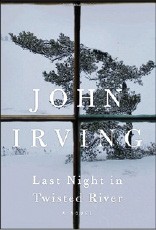
Last Night in Twisted River
By John Irving
Random House, 554 pp., $28
John Irving is up to much more than remarkable storytelling in his
12th novel, Last Night in Twisted River. In a seeming effort to
tease those eager to read autobiographical synergy into his fiction,
Irving goes one further.
The novel distills the author’s previous themes and motifs (bears,
death, missing limbs, sex with older women, tragedy and hope);
demonstrates his usual acrobatic performance with syntax and grammar
(there are actual discussions about the semicolon); displays his sheer
mastery of timing (the tantalizing dropped detail leading provocatively
to a full-blown narrative); and chronicles his own education and
literary craft — even the order of his novels — through one
of three central characters: the “famous writer” Daniel Baciagalupo
(nom de plume: Danny Angel).
Danny, whose father Dominic begins his career in a New Hampshire
logging camp, is baptized as a writer not by his beloved but
short-spoken father but by a profanity-spewing, maniacal logger named
Ketchum whose stories capture the young boy’s imagination and whose
love proves as powerful as the man himself.
One night in the cookhouse on Twisted River, Danny, age 12, mistakes
the cook’s lover for a bear and kills her, thus setting father and son
in motion. Under the guidance of Ketchum, the two begin a series of
moves hoping to stay ahead of the murdered woman’s boyfriend, a New
Hampshire sheriff more heinous than any criminal.
Thankfully, Irving’s humor provides a cushion for the tragedies
stalking the characters. “The Cook,” Irving writes, “had an aura of
controlled apprehension about him, as if he routinely anticipated the
most unforeseen disasters.”
The death of a beloved child — Twisted River has two
— answers Dominic’s trepidation. Irving commented tellingly in a
recent interview, “I’m in terror of losing a child. It’s never happened
to me, but I am clearly compelled to write about it over and over
again, and in a way I think, psychologically at least, this says more
about me autobiographically as a novelist than the fact that Danny
Angel goes to the Iowa Writers Workshop and has Kurt Vonnegut as a
teacher, which I also did.”
As Dominic insists, “There were not enough bends in Twisted River to
account for the river’s name.” The same cannot be said of this abundant
novel where Irving accepts his characters’ obsessive fears of loss and
loneliness while granting them warm-hearted appreciation for lives
fully lived. — Lisa C. Hickman

Strength In What Remains
By Tracy Kidder
Random House, 304 pp., $26
Strength in What Remains, by Tracy Kidder, is the true story
of not only what happens during a genocide but what it takes to survive
one.
Deo was a medical student doing an internship in rural Burundi in
1993 when civil war broke out. The Hutu president had been
assassinated, and in retaliation, Hutu countrymen began killing Tutsis.
Deo escaped being massacred by a Hutu militia and, keeping away from
the roads, made his way to Rwanda and a refugee camp. A few months
later, however, the same racial violence erupted in Rwanda, sending Deo
fleeing back into Burundi.
Neither place was safe, and a friend from medical school helped him
get to New York, where he arrived alone, with $200 in his pocket and
knowing no English.
With hard work, perseverance, and a little luck/fate/divine
intervention, Deo went from sleeping in New York’s Central Park to
taking classes at Columbia University. His goal: to become a doctor and
build a clinic in his village in Burundi.
Whereas accounts of genocide can sometimes blend into an
overwhelming wave of numbers and atrocities, the focus of this account
on a single individual makes it all the more heartbreaking. At
Columbia, for example, Deo takes philosophy classes to try to
understand how neighbors could kill neighbors, priests their
parishioners, and teachers their students.
This gripping book examines roughly the same question. The first
half is told from Deo’s point of view as he experienced it. The second
half includes interviews with the people who helped him and with an
older Deo.
There are no answers in genocide, but Deo’s story shows there are
ways to create peace. I never wanted to put the book down. —
Mary Cashiola
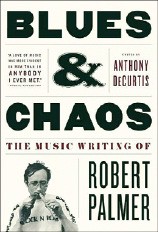
Blues & Chaos: The Music Writing of Robert Palmer
Edited by Anthony DeCurtis
Scribner, 452 pp., $30
Author of Deep Blues and indispensable histories of the
Rolling Stones and Jerry Lee Lewis, Robert Palmer is a complex and
contradictory figure in music criticism. As a Southerner, he grew up
the only white kid at soul and R&B shows in Little Rock; as a
musician, he jammed with Ornette Coleman, U2, and the Master Musicians
of Jajouka; and as a functioning junkie, he developed a habit that
would hasten his death in 1997.
Those facets contributed to his writing, in which he sought out the
sincere, the passionate, and the transcendent in a range of musical
styles and traditions. Palmer emerges as irascibly opinionated,
obsessively fascinated, yet soberly matter-of-fact in this new
collection of interviews, articles, reviews, profiles, and other short
pieces.
The breadth of genres and artists covered in Blues &
Chaos can be astonishing. He humanizes Ray Charles, Jerry Lee
Lewis, and Muddy Waters, albeit with subtle fawning in his prose. He
engages more closely and critically with artists of his own and
subsequent generations, including the Band, Eric Clapton, Elvis
Costello, and, in particular, John Lennon.
Despite its shortcomings, Blues & Chaos refuses to gloss
over Palmer’s faults but instead portrays him as a man with deep blues
of his own.
— Stephen Deusner
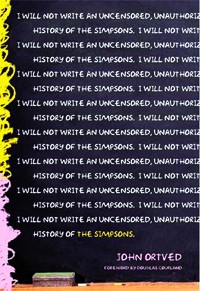
The Simpsons: An Uncensored, Unauthorized History
By John Ortved
Faber & Faber, 352 pp., $27
John Ortved’s The Simpsons has a few things in common with the
animated series whose story it tells. It begins as a risky curiosity
that may or may not fly, grows into an engaging soap opera, then wears
out its welcome long before there’s any end in sight.
Ortved’s oral history of television’s longest-running animated
series is emphatically historical. It’s not a lesson in comedy writing
or an insider’s guide to making a hit TV show, and it’s never
particularly funny. The cast of characters, however, ranges from media
mogul Rupert Murdoch to Deborah Groening, the ambitious ex-wife of
Simpsons creator Matt Groening, and they are every bit as
over-the-top as the inhabitants of Springfield.
“Rupert Mudoch, Barry Diller, Mad magazine, Saturday Night
Live, Fox, and Bill Cosby all had a hand in making The
Simpsons,” Ortved wrties. “As did all the crappy sitcoms it was
responding to, as well as the conservative culture that produced
them.”
The Simpsons history offers plenty of trivia for fans. But
Ortved is at his best when he channels the spirit of his subject
matter: “We thought we were writing these really funny, smart, special
shows,” writer/producer Jay Kogen is quoted as saying. “And then
someone showed us this study Fox had done. The number-one reason people
liked The Simpsons was ‘all the pretty colors’ and they liked it
when Homer hit his head.” — Chris Davis

The Simple Little Vegan Dog Book: Cruelty-Free Recipes for
Canines
By Michelle A. Rivera
Book Publishing Company, 80 pp., $9.95 (paper)
As a vegan, I avoid meat, eggs, and dairy. I don’t wear leather,
silk, or wool. So you can imagine the conflict I face every day as I
feed my dog and six cats pet food made from ground, processed meat.
Although commercial vegan pet food is available, it’s out of my price
range.
Enter The Simple Little Vegan Dog Book by Michelle A. Rivera,
a cute volume of homemade entrées, biscuits, and
special-occasion treats for canines. According to Rivera, dogs, like
humans, are omnivores and can get their nutrients from meatless
meals.
My dog Datsun certainly didn’t miss the meat in Snoopy’s Great
Pumpkin, Rice, and Beans (canned pumpkin, brown rice, and red beans),
and he begged for more Barking Barley and Wheat Surprise (a casserole
of lentils, barley, and whole-wheat flour). Each night, I reward him
with a homemade Yeasted Gourmet Dog Treat, cut into bone shapes using a
cookie cutter.
Rivera explains that most commercial dog foods are loaded with
slaughterhouse byproducts and “4D meat (meat from animals that are
dead, diseased, dying, or disabled).” It’s meat unfit for human
consumption, so she argues that we shouldn’t pollute our pet’s health
with leftover scraps.
Rivera also provides succinct lists of which plant foods are
beneficial to dogs (like pumpkin and beans) and which ones they should
avoid (like chocolate and onions). As for cats, Rivera warns against
switching them to a meat-free diet. As obligate carnivores, she says
felines aren’t able to get the proper amount of taurine from a vegan
diet.
Although I’m not comfortable switching Datsun over to a full-on
vegan diet yet, I’ve begun supplementing one of his two daily meals
with a home-cooked vegan dinner from Rivera’s book. The best part?
Since his meals are totally vegan, we can share. — Bianca
Phillips

Odds/Ends: Xmas ’09 Edition
In this age of the Kindle (1 and 2) — and the Sony Reader and
the Nook and the forthcoming QUE — you remember that printed
product with pages that you not only sit with and think through but
dog-ear and mark the hell out of: books. And yes, they’re still making
them — in record numbers (the more crowd-pleasing the author
writing them, the bigger the number printed of them) but at a price
— a crazy-low price thanks to big-boxer Walmart and competitive
online retailers.
The alternative: Screw it. Don’t download the book. Support your
bookseller. And see here if it’s bookish ideas you need this Christmas
and if the person on the receiving end is the literary, arty type.
Caution: The following come with a price.
For that literary person on your list: A New Literary History of
America (Belknap Press/Harvard University Press). It’s got Greil
Marcus (hipster central) as an editor. It’s a thousand-plus pages. It’s
$49.95. And it’s alternative. How alternative? There’s an entry for the
National Football League. Sylvia Plath? Not so much.
Pop: the ’60s art movement that will not die. And how could it with
Warhol dead for decades but still inspiring every rising generation of
art kids who are 1) fed up with American commercialism but 2) ready to
cash in on American commercialism. See then: Pop: The Genius of Andy
Warhol (HarperCollins) by Tony Scherman and David Dalton, for $40.
Tony Shafrazi is crazy about this book. You don’t know who Tony
Shafrazi is? Never mind.
Weird: beauty pageants. Real weird: child beauty pageants. Simon
Doonan, a celebrated window dresser, is ga-ga — about child
beauty pageants. So ga-ga about them that he’s written the foreword to
High Glitz (powerHouse Books, $49.95) by Susan Anderson. Is this
the same Susan Anderson who authored Porn for New Moms and
Itty-Bitty Toys: How To Knit Animals, Dolls, and Other Playthings
for Kids?
Weirder still: the life of Nicky Haslam, and he writes of it in
Redeeming Features (Knopf, $30). Claim to fame? Among a ton of
other unessential stuff (including partying and decorating): sex with
Lord Snowden (before Snowden married Princess Margaret), and in the
’90s, he surgically reconstructed himself to look like a biker
(rough-trade division). BFFs include: Mick Jagger and painter Lucien
Freud, who’s a friend of …
Frank Auerbach, the English painter with paintings so dense with
paint the paint has trouble staying on the canvas. Doesn’t matter.
Auerbach’s a rarity: a great artist in the great tradition of English
portrait painting. He’s now, finally, really getting his due. The
book’s called Frank Auerbach (Rizzoli) by William Feaver. But
it’ll set you back 150 bucks.
That’s nothing. The limited-edition, signed, custom-slipcased
Alex Steinweiss: Creator of the Modern Album Cover (Taschen)?
It’s a whopping $500. Steinweiss’ album covers, beginning in the ’40s
and covering three decades? They were back then, they still are: the
locus classicus of “cool.” — Leonard Gill